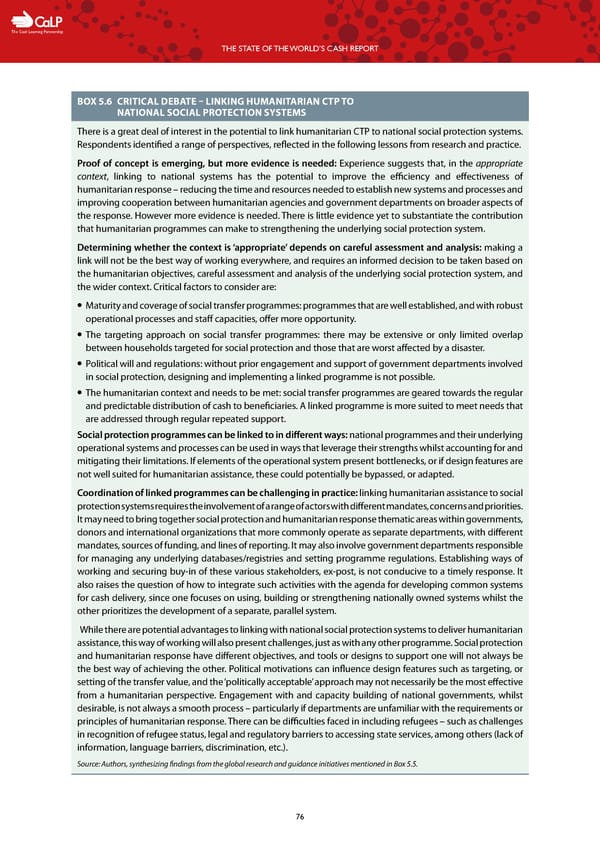C The Cash Learning Partnership THE STATE OF THE WORLD’S CASH REPORT BOX 5.6 CRITICAL DEBATE – LINKING HUMANITARIAN CTP TO NATIONAL SOCIAL PROTECTION SYSTEMS There is a great deal of interest in the potential to link humanitarian CTP to national social protection systems. Respondents identified a range of perspectives, reflected in the following lessons from research and practice. Proof of concept is emerging, but more evidence is needed: Experience suggests that, in the appropriate context, linking to national systems has the potential to improve the efficiency and effectiveness of humanitarian response – reducing the time and resources needed to establish new systems and processes and improving cooperation between humanitarian agencies and government departments on broader aspects of the response. However more evidence is needed. There is little evidence yet to substantiate the contribution that humanitarian programmes can make to strengthening the underlying social protection system. Determining whether the context is ‘appropriate’ depends on careful assessment and analysis: making a link will not be the best way of working everywhere, and requires an informed decision to be taken based on the humanitarian objectives, careful assessment and analysis of the underlying social protection system, and the wider context. Critical factors to consider are: — Maturity and coverage of social transfer programmes: programmes that are well established, and with robust operational processes and staff capacities, offer more opportunity. — The targeting approach on social transfer programmes: there may be extensive or only limited overlap between households targeted for social protection and those that are worst affected by a disaster. — Political will and regulations: without prior engagement and support of government departments involved in social protection, designing and implementing a linked programme is not possible. — The humanitarian context and needs to be met: social transfer programmes are geared towards the regular and predictable distribution of cash to beneficiaries. A linked programme is more suited to meet needs that are addressed through regular repeated support. Social protection programmes can be linked to in different ways: national programmes and their underlying operational systems and processes can be used in ways that leverage their strengths whilst accounting for and mitigating their limitations. If elements of the operational system present bottlenecks, or if design features are not well suited for humanitarian assistance, these could potentially be bypassed, or adapted. Coordination of linked programmes can be challenging in practice: linking humanitarian assistance to social protection systems requires the involvement of a range of actors with different mandates, concerns and priorities. It may need to bring together social protection and humanitarian response thematic areas within governments, donors and international organizations that more commonly operate as separate departments, with different mandates, sources of funding, and lines of reporting. It may also involve government departments responsible for managing any underlying databases/registries and setting programme regulations. Establishing ways of working and securing buy-in of these various stakeholders, ex-post, is not conducive to a timely response. It also raises the question of how to integrate such activities with the agenda for developing common systems for cash delivery, since one focuses on using, building or strengthening nationally owned systems whilst the other prioritizes the development of a separate, parallel system. While there are potential advantages to linking with national social protection systems to deliver humanitarian assistance, this way of working will also present challenges, just as with any other programme. Social protection and humanitarian response have different objectives, and tools or designs to support one will not always be the best way of achieving the other. Political motivations can influence design features such as targeting, or setting of the transfer value, and the ‘politically acceptable’ approach may not necessarily be the most effective from a humanitarian perspective. Engagement with and capacity building of national governments, whilst desirable, is not always a smooth process – particularly if departments are unfamiliar with the requirements or principles of humanitarian response. There can be difficulties faced in including refugees – such as challenges in recognition of refugee status, legal and regulatory barriers to accessing state services, among others (lack of information, language barriers, discrimination, etc.). Source: Authors, synthesizing findings from the global research and guidance initiatives mentioned in Box 5.5. 76
 The State of the World's Cash | Full Report Page 77 Page 79
The State of the World's Cash | Full Report Page 77 Page 79